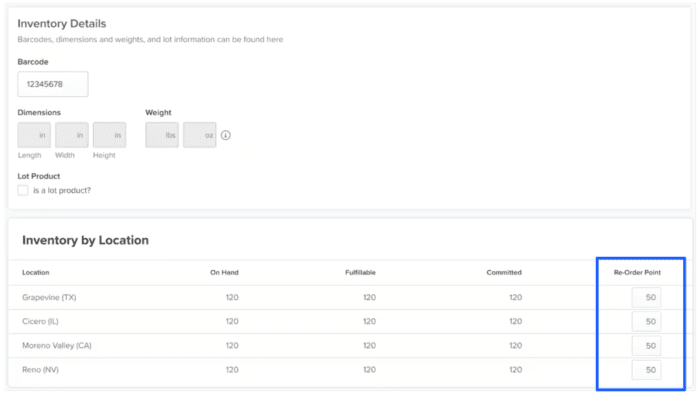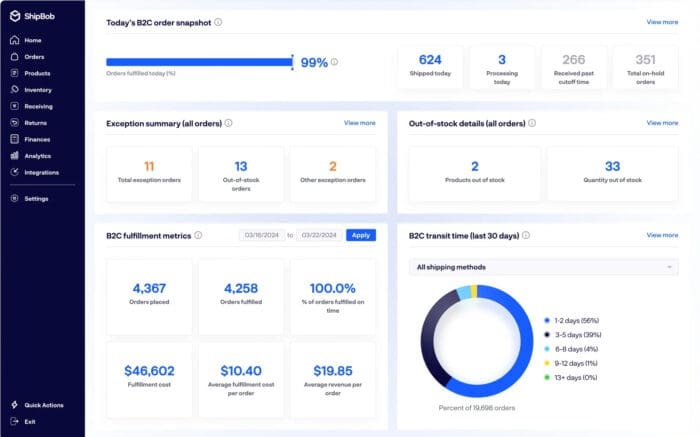You might think your ecommerce logistics are running smoothly – especially if orders are being processed, fulfilled, and shipped consistently. But chances are, there’s probably some waste in your operations that you haven’t noticed yet.
While physical waste such as discarded packaging is easy to spot, your brand may be suffering from more subtle, invisible forms of waste. Wasted time and effort on unnecessary processes, surplus staffing, inefficient inventory management, and more can all quietly eat into a business’s bottom line.
To minimize all forms of waste, many brands prioritize keeping their logistics lean. By managing logistics according to lean principles, you can improve your brand’s operational efficiency, reduce logistics costs, and ultimately facilitate a better experience for your customers.
In this article, we’ll take a look at the principles of lean logistics, highlight its benefits, and share some tips and best practices for making your own logistics operations leaner.
What is lean logistics?
Lean logistics is an approach to logistics management that focuses on identifying and eliminating waste in your supply chain. The goal of lean logistics is to remove any unnecessary processes or activities (that is, any processes or activities that don’t add value to your operations), so that you can improve the continuous flow of goods within your supply chain, which in turn reduces costs while boosting efficiency.
Key principles of lean logistics in ecommerce
Lean logistics operations are guided by a few key principles. When executed together, these principles help optimize ecommerce logistics for efficiency, cost, and productivity.
Waste reduction
Waste comes in many different forms in ecommerce, and a lean logistics operation aims to minimize all of them. Specifically, lean logistics focuses on reducing waste in:
- Time (including lead times and transit times)
- Materials (raw materials, packaging, etc.)
- Products (lost, damaged, or obsolete inventory)
- Effort (when human labor, focus, and attention devoted to unnecessary tasks)
Product flow improvement
Improving efficiency and throughput is also a key aspect of maintaining lean logistics. Lean logistics operations make sure that inventory flows seamlessly through the supply chain, and that various supply chain processes (including order processing, picking, packing, and shipping) are performed quickly and correctly, without unnecessary delays or interruptions.
Value stream mapping
Lean logistics relies on distinguishing value-adding elements of your operations from the superfluous ones.
As a result, making your logistics leaner requires you to map the value chain across your operations to pinpoint which activities aren’t necessary, which ones are experiencing delays and restraints, and which ones add value.
That way, you can build on the value-added activities while eliminating the unnecessary ones.
Lean logistics vs. traditional logistics
Traditional logistics prioritize outcome over process. While traditional logistics focus on executing all the necessary tasks to get orders to customers, little attention gets devoted to how these tasks are executed. This means that traditional logistics systems end up with:
- Outdated processes that lead to inefficiencies
- Higher labor and storage costs
- Excess or obsolete inventory
Lean logistics, on the other hand, focuses on delivering the same highest-quality output with as little wasted time, effort, and materials as possible. This approach is more customer-centric than traditional logistics, and often results in a streamlined fulfillment and shipping process that achieves a more timely, accurate, and inexpensive delivery experience for the customer.
Lean logistics also better equip brands to navigate unexpected challenges than traditional logistics systems. When your supply chain involves very little waste or extraneous processes, it is easier to pivot in response to supply chain bottlenecks or unforeseen issues (such as weather disasters, global crises, and port delays). As such, lean logistics help brands stay agile and resilient.
How to successfully implement lean logistics in ecommerce
The principles of lean logistics look great on paper – but what do they look like in practice? Here are just a few of the ways brands can implement lean logistics management strategies in their own operations to minimize waste and improve efficiency.
Implement JIT (just-in-time) inventory management systems
Many ecommerce businesses try to prevent stockouts by ordering and holding a significant amount of inventory — but this strategy often results in overproduction and excess inventory, which inflates your holdings costs and ultimately leads to deadstock.
Implementing lean inventory management strategies such as the “just-in-time” system (or JIT) helps you address this issue. The just-in-time inventory strategy relies on a pull system, where inventory is acquired based on customer demand. This means that inventory is procured in small quantities and then quickly restocked according to customer needs.
This way, rather than holding copious amounts of inventory that may or may not sell, you always have just enough inventory on-hand to meet customer demand.
Although the just-in-time approach helps you reduce waste and minimize cost, it requires impeccable procurement timing and accurate demand forecasting. It’s important to have real-time inventory visibility so you always have an accurate picture of your inventory levels, which will allow you to plan your procurement accordingly.
Automatic reorder point notifications are also helpful, so that you’re immediately notified if your inventory count reaches a certain level. This enables you to restock just in time to support your just-in-time strategy.

Focus on operational efficiency in logistics operations
In lean logistics, every task a worker spends time on should be valuable and contribute to a goal. By auditing your warehouse processes and pinpointing extraneous or unhelpful processes, you can save your team a lot of time and effort across your operations.
Consider optimizing logistics operations like:
- Inventory receiving: Designate an area for receiving, and thoroughly count and inspect inventory for potential damage/inconsistencies.
- Warehouse layout: Arrange your warehouse so that workers can travel quickly and safely, keep aisles wide enough so that equipment can easily pass through, and store inventory in easily accessible locations for pickers to speed up the picking process.
- Picking: Reduce travel time using strategic pick lists that chart an efficient route through the warehouse, or implement a picking strategy like batch picking, zone picking, or wave picking to pick more orders in fewer trips.
- Packing: Make sure packers know exactly how to place items in boxes or bags.
Leverage automation
Supply chain automation tools help speed up logistics operations by minimizing the need for manual work. This may involve:
- Automated order processing software that quickly confirms order details (rather than manually entering in each order) and pushes them to the next stage of fulfillment
- Ideal inventory distribution tools that automatically assign orders to and fulfill orders from the ideal fulfillment center location to minimize shipping times and costs
- Box-selection algorithms that automatically identify the optimal packaging size for each order
- Automated sorting machines that scan every package to verify package dimensions and weights, and to automatically sort packages into various carrier lanes.
Drive optimization through data and analytics
Data is key to identifying where and how your logistics could be leaner. By consistently monitoring and analyzing supply chain performance KPIs, inventory analytics and order data, and fulfillment metrics, you can clearly see which areas of your logistics operations are performing optimally, and which are creating bottlenecks or running inefficiently.
For instance, brands can leverage real-time inventory tracking to make more informed decisions about reorder quantities and inventory control, and subsequently improve supply chain workflows and make continuous improvements to your logistics.
Benefits of a lean approach to logistics for ecommerce businesses
Going the extra mile to make your ecommerce logistics leaner can benefit your brand in many ways. Here are some of the main advantages to implementing lean logistics in your operations.
Reduced cost
Since lean logistics focuses on reducing waste and inefficiencies, this approach naturally minimizes costs associated with unnecessary transportation and movement, excess inventory, storage, and long wait times.
Increased profitability
Minimizing costs usually helps bolster your brand’s bottom line. Moreover, a higher operational efficiency and an improved order cycle time help you maximize profitability.
Enhanced customer satisfaction
Lean logistics aims to optimize your shipping logistics to speed up deliveries. Faster fulfillment processes and optimal delivery routes allow you to quickly get orders delivered to your customers, which leads to improved customer satisfaction.
Better supply chain flexibility
Applying lean practices prepares your business to quickly respond to changing customer demand, which improves your supply chain flexibility. When you reduce lead times and streamline your processes, you create an agile supply chain that’s capable of quickly adapting according to market and demand changes.
Increased sustainability
A lean approach to logistics can also make your operations more sustainable and eco-friendly. When you reduce waste in the form of excess inventory and packaging waste, you’re essentially adopting more sustainable practices in your supply chain execution. Additionally, improving your resource utilization and optimizing transportation routes helps to reduce your environmental impact.
Does lean logistics have a future in ecommerce?
Lean logistics doesn’t just have a future in ecommerce; it is the future of ecommerce.
With the promise of increased flexibility and efficiency along with better cost savings, lean logistics is absolutely key to remaining competitive and staying ahead of the curve in ecommerce. As such, lean practices and automation tools are quickly becoming must-haves, rather than nice-to-haves, for ecommerce brands.
Leveraging lean logistics, many brands have been able to:
- Provide 2-day shipping to compete with retail giants such as Amazon
- Build scalable operations that can handle increased order volumes
- Invest cost-savings in growing existing channels and expanding into retail partnerships, and marketplace platforms
- Devote time to strategic priorities such as marketing and product innovation
However, lean logistics don’t just happen on their own – it can take a lot of legwork. To make the process of streamlining logistics easier, many brands find it helpful to partner with a professional logistics provider like ShipBob.
ShipBob’s solutions can optimize your inventory management, fulfillment, and shipping operations for you, so that you can enjoy the benefits of lean logistics without the stress of implementing them yourself.
Tighten up your fulfillment logistics with ShipBob’s solutions
As an expert ecommerce logistics partner, ShipBob specializes in streamlining ecommerce brands’ logistics to save time, improve productivity, and reduce costs.
ShipBob’s powerful proprietary software and leading fulfillment services empower brands to run leaner logistics operations with top-quality results – and with both outsourced and in-house solutions, ShipBob’s team is ready to help any SMB and mid-market brand go lean.
Here are just some of the ways that ShipBob helps merchants achieve leaner logistics.
Track key metrics to gain new insights
Data is the foundation of any lean logistical operation – and with ShipBob as your partner, you’ll gain deep visibility into order fulfillment and inventory metrics, including:
- Inventory turnover rate
- Percentage of orders fulfilled on time
- Average fulfillment cost
- Average transit time
- Inventory on hand

Using these metrics, you can identify optimization areas and proactively improve your logistics operations.
Distribute inventory for faster, cheaper shipping
Shortening transit times and reducing unnecessary travel are core aspects of lean logistics. You can use ShipBob’s Ideal inventory distribution tool to identify the most optimal allocation of inventory across ShipBob’s network that will allow you to meet customer demand while minimizing your average shipping zone. This way, you can reduce shipping times and costs, and provide a better delivery experience for customers.
From there, ShipBob’s Inventory Placement Program will actually take care of this distribution for you. All merchants have to do is send inventory to one hub location, rather than multiple regional fulfillment centers, saving you the hassle and expense of multiple inventory shipments.
“We’re fulfilling orders from 4 ShipBob fulfillment centers on the West Coast, Southwest, Midwest, and Northeast. By storing inventory and fulfilling orders from 4 different regions, we’ve been able to engineer it so that most of our shipments are within Zones 1 and 2.
Eliminating high shipping zone ranges by distributing inventory is a no-brainer, and really helps us minimize our shipping costs, especially on high-velocity items.”
Neil Blewitt, SVP of Operations at Bloom Nutrition
Reduce overhead
When you outsource fulfillment to ShipBob, you hand off logistics to experts that are already equipped with the right infrastructure, staff, and equipment. You can then leverage their expertise to pick, pack, and ship orders for you, without investing in expensive warehousing and storage necessities yourself.
Car care brand AutoGeek, for instance, used to struggle with fixed costs for warehousing and labor, and was paying to maintain a 30-person team even when order volume was low. Outsourcing fulfillment to ShipBob gave them a flexible solution that cut overhead while still providing the labor they needed to handle spikes in demand effectively.
“When we had our own warehouse, our fulfillment costs were a lot higher. We’re already seeing those numbers go down with ShipBob. That helps with our margin a lot.”
John Lewis, President and COO of Vision Investments
Manage inventory in real time
With ShipBob’s inventory dashboard, you get real-time visibility into your inventory across the supply chain. This enables you to better control its movement and promptly respond to delays and disruptions.

You can clearly see how much inventory you have left and make replenishment orders in line with the just-in-time system. Moreover, you can pinpoint problem areas and fix them to keep products flowing seamlessly throughout the supply chain.
“With ShipBob, we finally got the visibility and analytics we were looking for. We get real-time insight into how much inventory to allocate to a specific warehouse, our current on-hand inventory levels, and how long each SKU is going to last by location. ShipBob provides a lot of distribution metrics, and everything presented is useful.”
Mithu Kina, Co-Founder and CEO of Baby Doppler
Implement ShipBob WMS to optimize in-house logistics
If you prefer to keep your fulfillment in-house, ShipBob’s powerful WMS helps you optimize your warehouse logistics according to lean principles. The platform serves as a single source of truth to give you more visibility into every aspect of your logistics processes, enabling you to better control your operations.
The WMS automatically processes your orders across all your sales channels and kickstarts the fulfillment process. It calculates optimal picking routes to ensure that your pickers can complete their picking lists with minimal back and forth. This drastically reduces picking time and helps you get orders out the door faster.
You can even use the WMS to put orders on hold if you’re not ready to ship them while releasing the orders you want to fulfill. This allows you to prevent backlogs and maintain a consistent inventory flow.
“Prior to ShipBob, we’d ship 300 orders/day. On that first night, we shipped 700 orders in the same timeframe. That speed is so valuable and so seamless.”
Rick Corbridge, COO at Infuze Hydration
To learn more about how ShipBob can make your logistics leaner, click the button below.
Lean logistics FAQs
Below are the most commonly asked questions about lean logistics.
What is lean logistics, and how does it differ from traditional logistics?
Lean logistics is a methodology that involves identifying and eliminating any activities that don’t add value to your logistics operations. It varies from traditional logistics in that focuses on reducing waste and inefficiencies that are common with traditional systems.
How can lean logistics improve efficiency in ecommerce fulfillment?
Lean logistics removes processes that are unnecessary and that may cause delays and disruptions. As such, it improves efficiency by ensuring that each activity serves a purpose and is performed quickly and accurately.
Can lean logistics help reduce shipping and fulfillment costs for ecommerce?
Yes, lean logistics helps reduce shipping and fulfillment costs for ecommerce businesses by eliminating unnecessary activities and minimizing waste.
How does ShipBob help ecommerce businesses achieve a lean logistics structure?
ShipBob enables ecommerce businesses to achieve a lean logistics structure by providing real-time inventory management, outsourced fulfillment, and strategic inventory distribution.
Is there a difference between lean logistics and lean supply chain management?
Lean logistics is a part of lean supply chain management. Lean logistics focuses on removing waste in logistics functions (such as order processing, picking, packing, and shipping), whereas lean supply chain management is a more wholistic approach and focuses on eliminating waste and inefficiencies across the entire supply chain (including manufacturing, procurement, and last-mile transportation).



